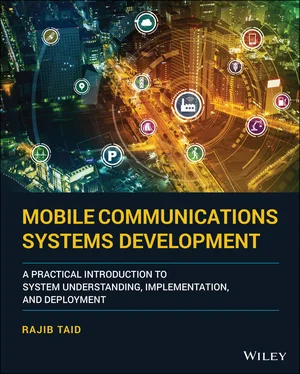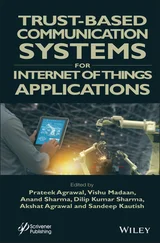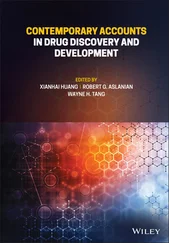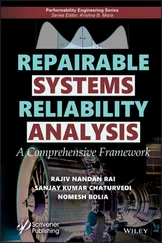ECM‐CONNECTED state, then the MMM notifies an incoming CS call by sending a CS SERVICE NOTIFICATION message to it.
MSC server sends the paging request, SGsAP‐PAGING‐REQUEST, to the MME over the SGs interface. MME further sent the paging message toward the UE through the eNodeB. MO UE completes the MO CS call as per the normal procedures with the MSC server. MT UE sends a paging response to the MSC server and completes the MT CS call as per the normal procedures illustrated in Figure 2.8earlier. Following this, both the UEs are connected in the legacy GSM network through CSFB arrangement and start voice/CS call conversations with each other.
In this example, illustrated in Figure 6.9, assume that the MT UE disconnected the CS call first, followed by the MO UE. In this case, the GSM BSC instructs both the UEs to release the allocated channels by sending the Channel Release message. This message also contains the LTE EARFCN number , indicating the UEs that they should return to the LTE network. Because of this, both the UEs perform their TAU procedure toward the MME to inform their current location within the LTE/EPS network.
In all of the air interface Layer 3 messages used for making a CS call in the legacy network, the flags CSMO , for the originating side, and CSMT , for the terminating side, are used and set accordingly to indicate to the receiving network element that the message is for CSFB purpose. These flags refer to TS 24.008 [45], are shown in Figure 6.9illustration. Table 6.1summarizes the network elements, their logical interfaces, and the related 3GPP TSs to support voice calls for LTE/EPS registered UE through the CSFB and SVRCC features.

Figure 6.9 Illustration: LTE voice call: MO‐MT voice call through CSFB.
Table 6.1 Interworking methods: network elements and their logical interfaces.
| Interworking Methods |
Network Elements |
Logical Interfaces |
Related 3GPP TSs |
| CSFB |
MME, MSC Server |
SGs |
23.272, 29.118, 36.413, 24.301, 23.401 |
| SRVCC |
MME, MSC Server SGSN, MSC Server |
Sv |
29.280, 23.401, 36.413 |
6.3 Interworking Through Legacy Network Elements
Figure 1(b), TS 23.002 [29], presents a basic interworking of the GSM, UMTS, and LTE/EPS networks that can be deployed by an operator with entirely new and upgraded/enhanced legacy network elements, e.g. SGSN, MSC, and RNC. However, another operator may choose to interwork its LTE/EPC network with the legacy GSM, GPRS, and UMTS core network elements, e.g. SGSN and MSC, only as its initial deployment. To realize successful interworking under such a scenario with legacy network elements, the EPC network elements will be required to support the necessary interfaces/protocols also that are used by the legacy core network elements, e.g. SGSN and MSC. One such interworking scenario is shown in Figure 6.10, reproduced from TS 23.401 [39].
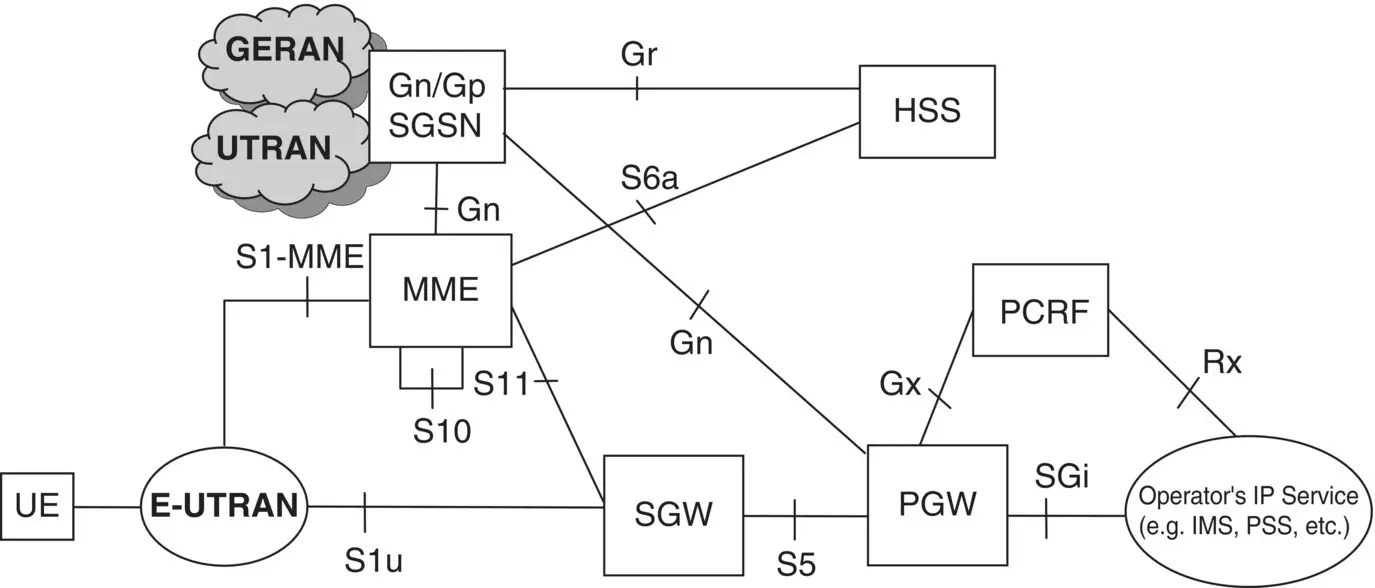
Figure 6.10 Interworking of LTE/EPS with GERAN and UTRAN through legacy network elements.
Source: © 2015. 3GPP ™ TSs and TRs are the property of ARIB, ATIS, CCSA, ETSI, TSDSI, TTA and TTC who jointly own the copyright in them. © 2015, 3GPP.
In Figure 6.10, only the representative figure for the GERAN and UTRAN networks along with the legacy SGSN is shown. The Gn interface works on top of the GTP and is used by the legacy GPRS and UMTS SGSN to communicate with the GGSN of a GPRS and UMTS network. The LTE/EPC MME communicates with the legacy SGSN over the Gn interface . LTE/EPC S‐GW also interfaces with the legacy SGSN through the Gn interface. The EPC HSS communicates with the SGSN through the existing Gr interface that works on top of the SS7 signaling protocols. On the other hand, the HSS communicates with the MME through the S6a interface that works on top of IP transport.
6.4 Interworking Between LTE/EPS and 5G Systems
In the previous section, interworking among the legacy systems has been described. To support seamless mobile communications services to subscribers during the inter‐system movement, the 5G system also provides interworking capabilities to operators. However, the 5G system supports interworking with the LTE/EPS only. For interworking between the 5G system and the LTE/EPS, the 3GPP defines a new inter core networks logical interface called N26 between the Access and Management Function (AMF) in 5G core network and the MME in the LTE/EPC network. It may be noted that interworking between the LTE/EPS and the 5G system can also take place without the presence of the N26 interface. Further, depending on the availability of the N26 interface between the 5GC/AMF and LTE/EPS MME for interworking between them, a UE can operate in one of the following modes:
Single Registration Mode, where the N26 logical interface is available between the 5GC/AMF and LTE/EPS MME.
Dual Registration Mode, where the N26 logical interface is not available between the 5GC/AMF and LTE/EPS MME.
Interworking between the 5G and the LTE/EPS with or without the N26 logical interface shall be described later in Chapter 16.
6.5 Interoperations of Networks: LTE/EPS Roaming
The roaming capability of a mobile communications network makes it possible to offer seamless voice and data services by a network operator to its subscribers while traveling outside of their home network and location and enter into a network that is run by the same or different operator in a different location. Roaming services are delivered to subscribers through the interoperation of networks operated by the same or another operator. Interoperation, in turn, is achieved through the interworking of network elements and interfaces as described in the previous sections.
In the previous Sections 6.2and 6.3, we have presented the interworking of the GSM, GPRS UMTS, and LTE/EPS networks, through the enhanced as well as legacy network elements, run by an operator. In this section, we further present the interoperations and interworking of mobile communications networks operated by different operators in different regions to provide roaming services to subscribers.
A mobile communications network operated by an operator to provide communications services in a particular area/location is known as the Public Land Mobile Network (PLMN) . A PLMN is uniquely identified, also see Section 5.2, by the combination of an MCC and MNC of an operator. Within a PLMN, an operator may provide both the voice (CS) and data services to subscribers. The PLMN in which an MS/UE is currently subscribed and registered in an LTE/EPS network is known as the home PLMN (HPLMN). The PLMN of either the same or different operator in which an MS/UE is currently roaming into and accessed the visited LTE/EPS network is known as the visiting PLMN (VPLMN).
6.5.1 Roaming Through Interoperations of Enhanced Networks Elements
In this interoperation and roaming scenario, the enhanced network elements for the LTE/EPS network are deployed both in the HPLMN and the VPLMN. There are two ways to transfer user data between the UE and the Internet in case of roaming between two different PLMNs with the enhanced network elements. To enable such roaming scenarios, new logical interfaces are used to interconnect among the network elements as described below:
Читать дальше
